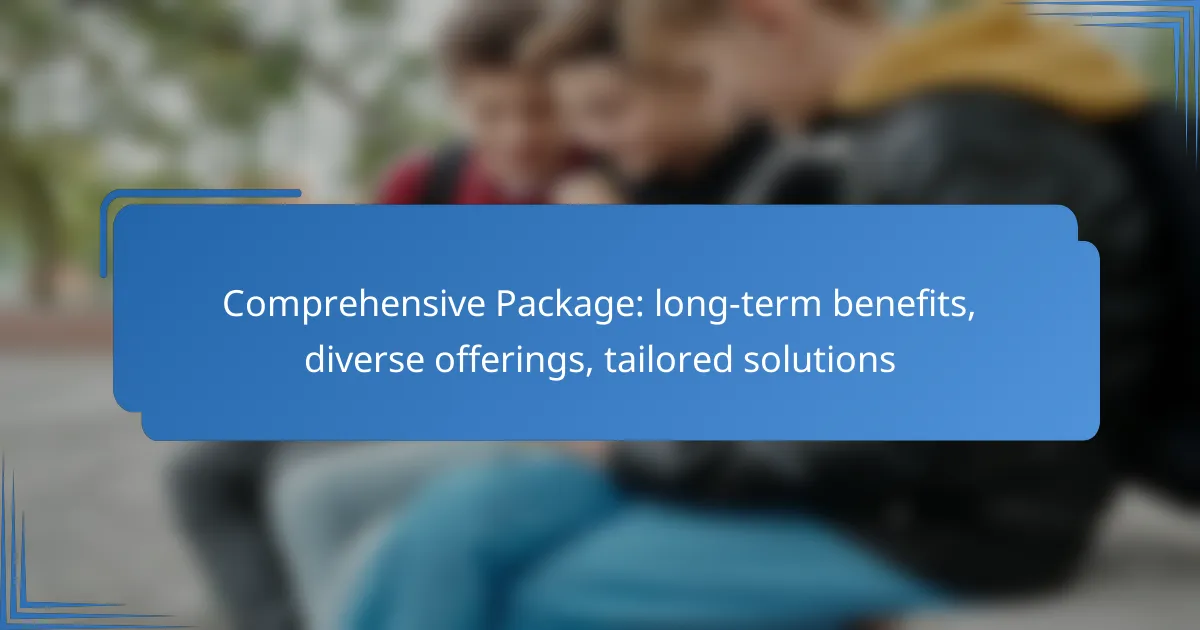Comprehensive packages in Australia deliver long-term benefits by combining cost efficiency with enhanced customer loyalty and service quality. These offerings are designed to meet diverse needs, providing tailored solutions that evolve alongside businesses, ensuring relevance and satisfaction.

What are the long-term benefits of comprehensive packages in Australia?
Comprehensive packages in Australia offer significant long-term benefits, including cost efficiency, enhanced customer loyalty, and improved service quality. These packages are designed to meet diverse needs, providing tailored solutions that adapt as businesses grow.
Cost savings over time
One of the primary advantages of comprehensive packages is the potential for cost savings. By bundling services, businesses can often secure lower rates compared to purchasing each service individually. This can lead to savings of up to 20% or more over time.
Additionally, comprehensive packages can reduce administrative costs, as fewer vendors mean less time spent on management and coordination. Businesses should evaluate their current spending to identify potential savings through bundled offerings.
Increased customer loyalty
Comprehensive packages foster increased customer loyalty by providing a seamless experience. When customers receive multiple services from a single provider, they tend to develop a stronger relationship with that provider, leading to repeat business.
Furthermore, loyalty programs often accompany these packages, incentivizing customers to stay engaged. Businesses should consider implementing such programs to enhance retention and encourage long-term partnerships.
Enhanced service quality
With comprehensive packages, service quality often improves due to streamlined processes and better integration of services. Providers can ensure consistency and reliability, which enhances the overall customer experience.
Moreover, businesses benefit from a single point of contact for support, making it easier to resolve issues quickly. This unified approach can lead to higher satisfaction rates among customers.
Streamlined operations
Comprehensive packages help streamline operations by consolidating various services into one cohesive solution. This reduces complexity and allows businesses to focus on their core activities rather than juggling multiple vendors.
By simplifying operations, companies can improve efficiency and productivity. It’s essential to regularly assess the effectiveness of these packages to ensure they meet evolving operational needs.
Scalability for future needs
Another key benefit of comprehensive packages is their scalability. As businesses grow, these packages can be adjusted to accommodate new requirements without the need for extensive restructuring.
Providers often offer flexible options that allow businesses to add or modify services as needed. This adaptability is crucial for companies looking to expand while maintaining operational efficiency.

How do tailored solutions meet diverse customer needs?
Tailored solutions effectively address diverse customer needs by providing customized offerings that align with specific industry requirements and individual preferences. This approach enhances customer satisfaction and fosters long-term relationships by ensuring that services or products are relevant and beneficial.
Customization options for various industries
Customization options allow businesses to adapt their solutions based on the unique demands of different industries. For example, a software company might offer specialized features for healthcare providers, such as compliance with HIPAA regulations, while a retail business may prioritize inventory management tools.
When considering customization, it’s essential to evaluate the specific challenges faced by your industry. Engaging with stakeholders can help identify critical features that will enhance usability and effectiveness, ensuring that the tailored solution truly meets their needs.
Flexible pricing models
Flexible pricing models enable customers to choose payment structures that align with their budget and usage patterns. Options may include subscription-based pricing, pay-as-you-go plans, or tiered pricing based on volume, allowing businesses to scale their expenses according to their growth.
When selecting a pricing model, consider the long-term financial implications and how they align with your cash flow. For instance, subscription models can provide predictable monthly expenses, while pay-as-you-go may be more suitable for businesses with fluctuating demand.
Personalized customer support
Personalized customer support enhances the user experience by providing tailored assistance based on individual customer needs. This can include dedicated account managers, customized training sessions, or 24/7 support tailored to specific time zones.
To maximize the effectiveness of personalized support, establish clear communication channels and ensure that support staff are well-trained in the specifics of your offerings. Regular feedback from customers can also help refine support strategies and improve overall satisfaction.

What diverse offerings are included in comprehensive packages?
Comprehensive packages typically include a variety of offerings designed to meet the specific needs of different sectors. These packages often combine products, services, and subscription models to provide tailored solutions that enhance efficiency and long-term value.
Product bundles for different sectors
Product bundles are collections of items grouped together to serve specific industries, such as healthcare, education, or retail. For example, a healthcare bundle might include medical software, diagnostic tools, and training resources, while a retail bundle could offer point-of-sale systems, inventory management, and customer engagement tools.
When considering product bundles, assess the unique requirements of your sector to ensure that the offerings align with your operational goals. Bundles can often provide cost savings compared to purchasing items individually, making them an attractive option for businesses.
Service integrations for efficiency
Service integrations involve combining various services to streamline operations and improve productivity. For instance, a business might integrate customer relationship management (CRM) software with marketing automation tools to create a seamless workflow that enhances customer engagement.
To maximize the benefits of service integrations, evaluate how different services can work together to eliminate redundancies and reduce manual tasks. Look for solutions that offer easy integration capabilities, as this can significantly enhance overall efficiency.
Subscription models for ongoing value
Subscription models provide continuous access to products or services for a recurring fee, ensuring businesses receive ongoing value. These models are common in software, where companies offer regular updates and support as part of the subscription package.
When selecting a subscription model, consider the total cost of ownership over time, including any potential price increases. Subscriptions can often lead to better budgeting and cash flow management, as they allow for predictable expenses rather than large, one-time purchases.

What criteria should be considered when selecting a comprehensive package?
When selecting a comprehensive package, it’s essential to evaluate compatibility with existing systems, scalability for future growth, and customer support along with service level agreements. These criteria ensure that the package meets current needs while being adaptable for future demands.
Compatibility with existing systems
Compatibility with existing systems is crucial for seamless integration and functionality. Assess whether the package can easily connect with your current software and hardware infrastructure without extensive modifications or additional costs.
Consider conducting a compatibility audit to identify potential issues. Look for solutions that support common standards and protocols, which can reduce integration time and costs.
Scalability for future growth
Scalability refers to the package’s ability to grow alongside your business. A scalable solution should accommodate increasing demands without significant performance degradation or the need for a complete overhaul.
Evaluate options that allow for modular upgrades or additional features as your requirements evolve. This flexibility can save costs in the long run and ensure that your investment remains relevant.
Customer support and service level agreements
Customer support and service level agreements (SLAs) are vital for ensuring that you receive timely assistance and clear expectations regarding service performance. Look for packages that offer robust support options, including 24/7 availability and multiple contact methods.
Review the SLAs to understand response times, uptime guarantees, and penalties for non-compliance. A strong support framework can significantly enhance your experience and minimize downtime, which is critical for business operations.

How do comprehensive packages compare to traditional offerings?
Comprehensive packages provide a more integrated approach than traditional offerings, often leading to enhanced long-term benefits and tailored solutions. These packages typically combine various services and products, making them more efficient and cost-effective for users.
Cost-effectiveness analysis
Comprehensive packages often result in significant cost savings compared to traditional offerings. By bundling services, companies can reduce overhead costs and pass those savings on to customers. For instance, businesses may find that opting for a comprehensive package can lower expenses by 15-30% compared to purchasing services individually.
When evaluating cost-effectiveness, consider both direct savings and potential long-term benefits. A comprehensive package may require a higher upfront investment, but the overall return on investment (ROI) can be favorable due to reduced maintenance and operational costs over time.
Service breadth and depth
Comprehensive packages typically offer a wider range of services than traditional options, allowing for greater customization and flexibility. This breadth means that customers can access multiple solutions under one umbrella, which can simplify management and enhance user experience.
In terms of depth, comprehensive packages often provide specialized services that address specific needs. For example, a comprehensive IT service package might include cybersecurity, cloud storage, and technical support, ensuring that all aspects of a business’s technology are covered. This holistic approach can lead to improved efficiency and better alignment with business goals.
